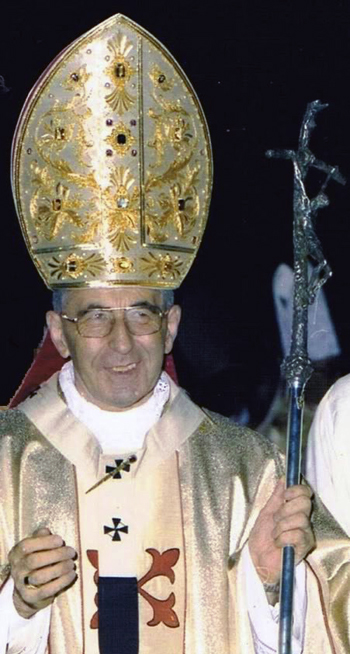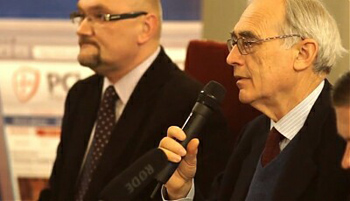Traditionalist Issues
 |
 |
 |
 |
 |
 |
 |
Real Council & Virtual Council – V
Mattei ‘Forgot’ John Paul I’s
Part in the Conciliar Revolution
Blaming the media for all the bad consequences of Vatican II, Roberto de Mattei purposely ignored that most of those deleterious fruits came from direct initiatives of the recent Popes. I have showed already the role played by John XXIII (here and here) and Paul VI (here and
here). Today, I will address what John Paul I did to further the Conciliar Revolution in his brief pontificate.
To refresh the memory of my reader, I believe that Roberto de Mattei is one of these “Made in the Vatican" traditionalists whose purpose is to cover for the progressivist Popes, anesthetize counter-revolutionary reactions against Vatican II, and to ultimately bring various segments of traditionalism under Vatican control.
Pope Paul VI died on August 6, 1978, ending his destructive reign of 15 years. Faithful Catholics, who had been witnessing the massive progressivist infiltration into the Church, the relaxation of morals and the desacralization of the liturgy, were praying for a strong and holy Pope who would steer the Bark of Peter away from the rocks. Their hopes were dashed merely upon hearing the name the new Pontiff chose: John Paul I.
 This name was the first double name for a Pope in the History of the Church, combining the names of the two Conciliar Popes; John XXIII and Paul VI. The message sent by this choice was clear: The Conciliar Revolution launched by John XXIII and Paul VI would continue.
This name was the first double name for a Pope in the History of the Church, combining the names of the two Conciliar Popes; John XXIII and Paul VI. The message sent by this choice was clear: The Conciliar Revolution launched by John XXIII and Paul VI would continue.
As a bishop, Albino Luciani participated in all the sessions of the Second Vatican Council. During his 33-day reign, John Paul I would not reverse any of the harmful changes of his conciliar predecessors; instead he would impose new changes of his own. He was the one who stopped wearing the papal tiara and the sedia gestatoria with the solemn flabelli.
At the start of his pontificate, John Paul I refused to have the millennium-old papal coronation and substituted it with what is now known as the papal inauguration. As a result, he was given a pallium instead of the traditional tiara. This was a radical step towards the desacralization and destruction of the Papal Monarchy. With the new inauguration ceremony, the pope appears more like a president than a monarch, and the three succeeding popes – John Paul II, Benedict XVI, and Francis – would also continue to be “inaugurated.”
John Paul I was the first modern pope to speak in the singular form, using “I” instead of the majestic “we,” although the official records of his speeches were often rewritten in more formal style by aides, who reinstated “we” in press releases and L’Osservatore Romano. These post-factum corrections ceased with John Paul II, who adhered completely to the “I” in his speeches and documents.
During his Angelus speech of September 17, 1978, John Paul I praised the known Mason and Satanist, Giosue Carducci, whose most famous work is Hymn to Satan or Ode to Satan. Carducci was one of the main figures in the Resorgimento, which brought about the theft of the Papal States, the persecution of the Church and Pope Pius IX, and the destruction of Christian Civilization in Italy. Notwithstanding, John Paul I pointed to Carducci as a model for Italian University Professors…
In his Allocution at the Angelus of September 10, 1978, John Paul said; “God is our Father and, even more, He is our Mother” (Fumus Satanae, page 31). Here we have the Pope promoting the Doctrine of the Eternal Feminine, an essential teaching of Progressivism that has infested the Church since Vatican II. For more understanding of this gnostic doctrine of the Eternal Feminine, please read Atila Guimarães’ new book, Fumus Satanae (the Smoke of Satan), Vol. 8 of the series Eli, Eli, Lamma Sabacthani?
So, even in the very short reign of John Paul I, we see that the Conciliar Revolution marched on.
 When Roberto de Mattei pretends to present a “historical perspective” of the Second Vatican Council in his speech, in truth, this Vatican-supported “scholar” is falsifying the historic truth about Vatican II.
When Roberto de Mattei pretends to present a “historical perspective” of the Second Vatican Council in his speech, in truth, this Vatican-supported “scholar” is falsifying the historic truth about Vatican II.
An example of this falsification can be found in his speech in Krakow (114:25 mark). (1) First, Mattei repeats the words of Benedict, “It was not the Council we wanted, it was a different Council, because … the implementation of the Council in the last 30, 40 years, was imposed by the media, and it was not the mind of the Fathers.”
Then, instead of historically refuting this absurd idea, as I am doing in this series, Mattei simply added: “What I say [in my book] is that it is very difficult to make a distinction between … the real Council and the media Council. As an historian I try to define the very essence of the Council … [a historian] has to look at this soil for the unifying moment of the two essences [real Council and virtual Council]”
It is not the media that is responsible for the Vatican II and its aftermath. The media reported the events, took pictures and videos, but it was the actions and words of the Conciliar Popes and members of the Hierarchy who caused the Conciliar Revolution.
Continued

To refresh the memory of my reader, I believe that Roberto de Mattei is one of these “Made in the Vatican" traditionalists whose purpose is to cover for the progressivist Popes, anesthetize counter-revolutionary reactions against Vatican II, and to ultimately bring various segments of traditionalism under Vatican control.
Pope Paul VI died on August 6, 1978, ending his destructive reign of 15 years. Faithful Catholics, who had been witnessing the massive progressivist infiltration into the Church, the relaxation of morals and the desacralization of the liturgy, were praying for a strong and holy Pope who would steer the Bark of Peter away from the rocks. Their hopes were dashed merely upon hearing the name the new Pontiff chose: John Paul I.

JPI abandoned the tiara at the first papal 'inauguration'
As a bishop, Albino Luciani participated in all the sessions of the Second Vatican Council. During his 33-day reign, John Paul I would not reverse any of the harmful changes of his conciliar predecessors; instead he would impose new changes of his own. He was the one who stopped wearing the papal tiara and the sedia gestatoria with the solemn flabelli.
At the start of his pontificate, John Paul I refused to have the millennium-old papal coronation and substituted it with what is now known as the papal inauguration. As a result, he was given a pallium instead of the traditional tiara. This was a radical step towards the desacralization and destruction of the Papal Monarchy. With the new inauguration ceremony, the pope appears more like a president than a monarch, and the three succeeding popes – John Paul II, Benedict XVI, and Francis – would also continue to be “inaugurated.”
John Paul I was the first modern pope to speak in the singular form, using “I” instead of the majestic “we,” although the official records of his speeches were often rewritten in more formal style by aides, who reinstated “we” in press releases and L’Osservatore Romano. These post-factum corrections ceased with John Paul II, who adhered completely to the “I” in his speeches and documents.
During his Angelus speech of September 17, 1978, John Paul I praised the known Mason and Satanist, Giosue Carducci, whose most famous work is Hymn to Satan or Ode to Satan. Carducci was one of the main figures in the Resorgimento, which brought about the theft of the Papal States, the persecution of the Church and Pope Pius IX, and the destruction of Christian Civilization in Italy. Notwithstanding, John Paul I pointed to Carducci as a model for Italian University Professors…
In his Allocution at the Angelus of September 10, 1978, John Paul said; “God is our Father and, even more, He is our Mother” (Fumus Satanae, page 31). Here we have the Pope promoting the Doctrine of the Eternal Feminine, an essential teaching of Progressivism that has infested the Church since Vatican II. For more understanding of this gnostic doctrine of the Eternal Feminine, please read Atila Guimarães’ new book, Fumus Satanae (the Smoke of Satan), Vol. 8 of the series Eli, Eli, Lamma Sabacthani?
So, even in the very short reign of John Paul I, we see that the Conciliar Revolution marched on.

In Krakow false right Roberto de Mattei, with the microphone, trying to save Vatican II
An example of this falsification can be found in his speech in Krakow (114:25 mark). (1) First, Mattei repeats the words of Benedict, “It was not the Council we wanted, it was a different Council, because … the implementation of the Council in the last 30, 40 years, was imposed by the media, and it was not the mind of the Fathers.”
Then, instead of historically refuting this absurd idea, as I am doing in this series, Mattei simply added: “What I say [in my book] is that it is very difficult to make a distinction between … the real Council and the media Council. As an historian I try to define the very essence of the Council … [a historian] has to look at this soil for the unifying moment of the two essences [real Council and virtual Council]”
It is not the media that is responsible for the Vatican II and its aftermath. The media reported the events, took pictures and videos, but it was the actions and words of the Conciliar Popes and members of the Hierarchy who caused the Conciliar Revolution.
Continued
- 114:25 “And for the last question. I think that the speech of Benedict XVI I have quoted, his last speech, a speech which was both a manifesto and a retrospective of his life, was coherent with his participation in the Council. This speech of Benedict XVI seems to say, ‘The Council that was realized, it was not the Council we wanted, it was a different Council, because the teaching, the implementation of the Council in the last 30, 40 years, was imposed by the media, and it was not the mind of the Fathers.’ It seems to say this. But what I say is that it is very difficult to make a distinction between the Document and the Spirit, the real Council and the media Council. As an historian I try to define the very essence of the Council. If I were not an historian, but if I were a theologian, it would be different. Because what characterizes the theologian is to distinguish, it is to articulate his thinking. But [the historian] has to look at this soil for the unifying moment of the two essences. So what I do in my book is this.”

Posted April 17, 2015
______________________
______________________












